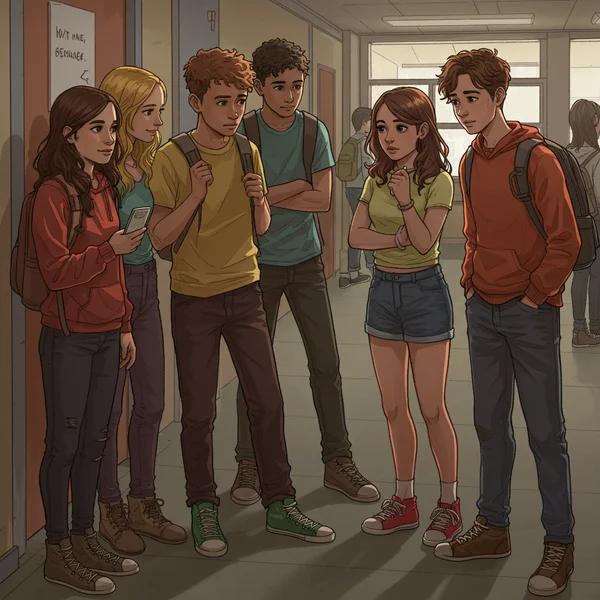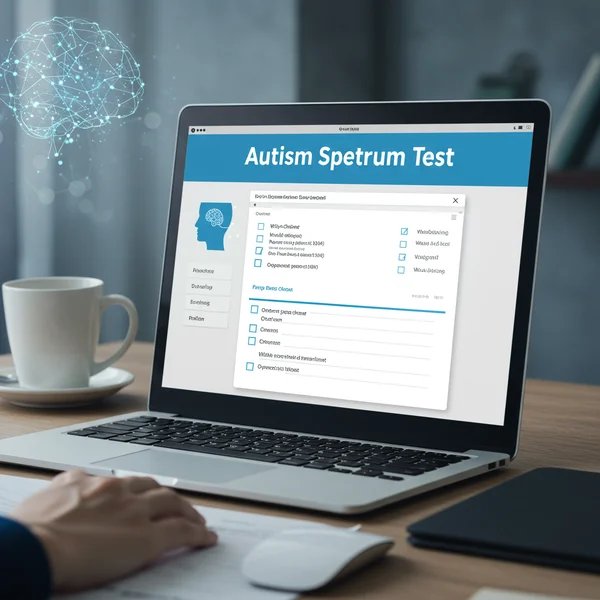Autism Spectrum Test Guide: Signs in Kids & Teens
As a parent or guardian, you are the foremost expert on your child. You notice the subtle shifts in their mood, the unique ways they play, and how they connect with the world. Sometimes, you may observe developmental differences that leave you with questions. If you've observed patterns that raise questions about autism in your child or teen, know that you're in a supportive space. This guide is designed to walk you through common indicators across different age groups, offering empathetic, evidence-based insights to empower your family's journey. What are the signs of autism in children? Understanding these can be the first step towards providing the right support.

While navigating this journey can feel overwhelming, having clear information can truly empower you. A structured approach, like a preliminary autism spectrum test, can help organize your observations and guide your next steps. For a confidential and science-based starting point, you can try a free autism test on our platform, designed for various age groups.
Early Autism Signs in Infants & Young Children
Recognizing signs of autism spectrum disorder (ASD) early on can make a significant difference in a child's developmental trajectory. While every child develops at their own pace, certain patterns in social interaction, communication, and behavior can be early indicators. Focusing on these signs is not about labeling but about understanding and opening doors to support. This is a crucial part of identifying the need for a childhood autism spectrum test.

What to Look For in Developmental Milestones
For infants between 0 and 18 months, early signs often relate to social and communicative milestones. During this period, you might observe:
- Limited Eye Contact: The baby may not make or sustain eye contact with caregivers.
- Delayed Social Smiling: Not offering warm, joyful smiles in response to others by six months.
- Lack of Response to Name: By nine to twelve months, not consistently turning or reacting when their name is called.
- Minimal Gesturing: Not using gestures like pointing, showing, reaching, or waving by 12-14 months.
- Infrequent Imitation: Little to no mimicking of sounds or facial expressions by nine months.
Observing one or two of these signs in isolation is not necessarily a cause for alarm. However, a consistent pattern across several areas may warrant a conversation with your pediatrician.
Common Autism Behaviors in Toddlerhood
As children enter the toddler years (18-36 months), signs can become more apparent in their play and interaction. This is the age when tools like the M-CHAT-R/F are often used for screening. Key behaviors to note include:
- Delayed Speech or Atypical Language: This can range from being nonverbal to having a good vocabulary but not using it for conversation. They might also engage in echolalia—repeating words or phrases they hear.
- Preference for Solitary Play: The child may show little interest in playing or interacting with other children, often preferring to play alone.
- Repetitive Behaviors: This can manifest as lining up toys, flapping hands, rocking their body, or spinning in circles. This is often referred to as stimming.
- Intense Sensory Sensitivities: They may have extreme reactions to certain sounds, textures, smells, or lights. Conversely, they may seem under-reactive to pain or temperature.
Autism Signs in Preschool & School-Aged Children
By the time a child reaches preschool and elementary school, social dynamics become more complex. Signs of autism at this stage often involve challenges with navigating these social rules. You might see:
- Difficulty Making or Keeping Friends: They may struggle to understand social cues, take turns in conversation, or share in others' interests.
- Need for Strict Routines: A strong insistence on sameness and extreme distress when routines are disrupted.
- Deep, Narrow Interests: An intense, all-consuming interest in a specific topic, like trains, dinosaurs, or a particular video game, to the exclusion of other activities.
- Literal Interpretation of Language: Struggling to understand sarcasm, idioms, or jokes.
Recognizing Autism Signs in Teens
Identifying autism in teenagers can be complex because some traits may overlap with typical adolescent behavior. However, the underlying reasons for their challenges are often different. The social pressures of high school can make these differences more pronounced, making an autism spectrum test for teens a valuable tool for understanding.

Social & Communication Differences in Adolescents
For many autistic teens, the biggest challenge is navigating the increasingly nuanced social world. While they may have a strong desire for friendships, they often struggle with the "how."
- Apparent Social Awkwardness: Conversations may feel stilted or one-sided, often revolving around their specific interests.
- Trouble with Nonverbal Cues: Difficulty interpreting body language, facial expressions, and tone of voice, which can lead to misunderstandings.
- Challenges with Peer Relationships: They may find small talk exhausting and prefer interacting with adults or younger children, where social rules are clearer.
- Difficulties with Emotional Regulation: May have trouble identifying and managing their own emotions, leading to meltdowns or shutdowns when overwhelmed.
Repetitive Behaviors & Restricted Interests in Teenagers
Repetitive behaviors and deep interests continue into the teen years, though they may evolve in their expression.
- Intense and Specific Interests: These interests often become more sophisticated, such as coding, astronomy, or a particular musical genre. While these can be great strengths, they can also interfere with other responsibilities.
- Subtler Stimming: Teens may learn to use more socially acceptable forms of stimming (repetitive self-stimulating behaviors) as coping mechanisms, such as doodling, tapping a pen, or fidgeting with an object.
- Reliance on Routine: The need for predictability remains strong. Unexpected changes in plans, schedules, or environments can cause significant anxiety.
Why Autism Signs in Girls & Teens are Often Missed
It is crucial to recognize that autism can present differently in girls. Many autistic girls become highly skilled at "masking" or "camouflaging" their traits to fit in with their peers. They may meticulously study social interactions and consciously mimic others' behaviors. This immense effort can be mentally and emotionally exhausting and is a primary reason why many girls are diagnosed late or misdiagnosed with conditions like anxiety or depression. A childhood autism spectrum test can help uncover underlying traits that might otherwise be overlooked.
Initial Screening Tools for Childhood Autism
If you've recognized several of the signs mentioned above, you may be wondering what to do next. An initial screening is a valuable step to gather more structured information before seeking a formal evaluation.
Understanding the M-CHAT-R/F for Toddlers
One of the most widely used and validated screening tools for toddlers is the Modified Checklist for Autism in Toddlers, Revised with Follow-Up (M-CHAT-R/F). It is designed for children between 16 and 30 months old. This questionnaire, which you can learn more about from authoritative sources like the CDC, asks parents yes/no questions about their child's behavior, such as whether they point to show interest or respond to their name. A positive screening on the MCHAT test does not mean a child is autistic; it indicates that the child would benefit from a more thorough developmental evaluation by a professional.
How Online Screening Tools Can Help Parents
For parents of children and teens, online screening tools provide a confidential, accessible first step. A good online autism screening is based on established research and can help you organize your thoughts and observations into a clear summary. It transforms vague worries into structured data points that can be incredibly helpful when you decide to speak with a doctor or specialist.

Our platform offers a free, science-based autism test tailored to different age groups. After answering a series of questions, you receive an immediate summary of traits. For those seeking deeper understanding, we also offer an optional AI-powered report that provides personalized insights into potential strengths, challenges, and actionable next steps. This can be an empowering tool on your journey. Ready to gain clearer insights? We invite you to explore our confidential test today.
Empowering Parents: Your Next Steps in Understanding Autism
Observing signs of autism in your child or teen is the beginning of a journey toward deeper understanding and support. Remember, autism is a form of neurodiversity, not a deficit to be fixed. Your child has unique strengths and a valuable perspective on the world. The goal is to provide them with the tools and environment they need to thrive.
Using a screening tool, talking to a pediatrician, and seeking a professional evaluation are all proactive, loving steps you can take. You are not alone on this path. If you're ready to gain clearer insight, we invite you to take the first step on our homepage. Your insights and experiences are invaluable. Feel free to share your thoughts or questions in the comments below; together, we can build a strong community of support.
Frequently Asked Questions About Childhood Autism Signs
What are the common autism signs in children?
Common signs revolve around two core areas: social communication and repetitive behaviors. For social communication, this can include delayed speech, difficulty with back-and-forth conversation, limited eye contact, and trouble understanding nonverbal cues. For behaviors, this includes repetitive movements (stimming), a strong need for routine, intense interests in specific topics, and sensory sensitivities.
Can children be mildly autistic?
Yes. Autism is a spectrum, meaning it affects every individual differently and with varying levels of intensity. Some individuals may have what was previously called "high-functioning autism" or Asperger's syndrome, where they have strong language skills but significant social challenges. They may require less support than others but still benefit from understanding and accommodations.
What should I do if my child shows autism signs?
First, document your observations. Second, use a reliable online screening tool, like the signs of autism test available on our site, to structure your concerns. Third, schedule an appointment with your child's pediatrician to discuss your observations and screening results. They can refer you to a specialist, such as a developmental pediatrician or child psychologist, for a formal diagnostic evaluation.
Is the M-CHAT test accurate for toddlers?
The M-CHAT-R/F is a highly validated and accurate screening tool. Its purpose is not to diagnose autism but to identify children who are at high risk and should receive a more comprehensive developmental evaluation. When used correctly, it is very effective at catching early signs that might otherwise be missed, allowing for earlier access to support services.